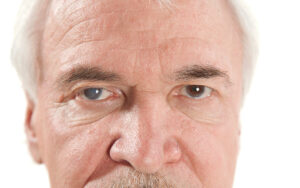Blepharoplasty
[/vc_column_text][/vc_column][/vc_row][vc_row][vc_column][vc_column_text]An eyelid lift, or blepharoplasty, is the excision of excessive eyelid skin, for functional or cosmetic purposes, with or without fat. Blepharoplasty of the upper lid may be performed traditionally, or modified with radiosurgery or laser incisional techniques. During human conversation and communication, the eyes and periorbital area are commonly the focal points. It may convey an inappropriate message of tiredness or sadness. An absence of vigor changes in the eyelid can also be caused by aging, which may diminish the aesthetic appearance of the face. If dermatochalasis or steatoblepharon is significant, they can also cause pseudoptosis.Associated Symptoms
A symptom of excessive eyelid skin is obscuration of superior visual fields. The landmarks of periorbital anatomy are influenced by sex, race, and age. These unique anatomic relationships are an important framework when surgical alterations of the periorbital are designed. On different sexes and races, the structures around the eyes differ significantly among people. For example, the cephalometric dimensions of the periorbital region are different in men and women. In the case of men, the eyelid crease is closer to the eyelid margin and the brow protrudes more anteriorly. In the case of women, the brow and lid crease are higher and more arched and the lid fold is less prominent. The eyelid margin in the case of many Caucasian men is 6-9mm. In the case of Caucasian women, the crease is usually 8-11mm above the lid margin. In the Asian population, the lid crease can be absent, nasally tapered, or flat. This is because the orbital septum attaches to the levator aponeurosis slightly above the superior tarsal border or over the anterior surface of the tarsus. Eye structures can also change over time with age.
Examination
Before performing blepharoplasty surgery, surgeons must evaluate the periorbital aesthetic relationships. A basic ophthalmologic examination that includes testing for dry eyes, including visual acuity, must also be performed. Blepharoplasty can be performed as an isolated procedure, rejuvenation of the upper and lower face, or in combination with ptosis repair. The position of the forehead, brows, cheek complex, and the natural aging process contributes to the position and appearance of the eyelids. Degenerative changes in the facial skeletal and soft tissues lead to loss of elasticity of the skin, the descent of the facial units, rhytides, fat atrophy, and redistribution. These features are evaluated in the assessment of the upper eyelid when planning surgical procedures to alter the periorbital tissue. Eyes are an important facial unit aesthetically, as well as a sensitive projector of facial aging. Patients may experience sad eyes, tired eyes, or extra tissue around the eye. Traditional upper lid blepharoplasty technique involves intricate surgery, along with psychological consideration for candidates undergoing cosmetic surgery.
Procedure
Upper eyelid blepharoplasty is performed for various functional or cosmetic indications. The upper eyelid protects the globe, distributes tears on the surface of the eye, and facilitates the drainage of tears through the lacrimal apparatus. The physician must determine whether a surgical procedure is indicated if any of these functions are impaired. Significant ptosis of the upper eyelid can block vision. Beneficial results from the upper eyelid blepharoplasty procedure include a greater visual field and improved quality of life in association with improved vision and reduced number of headaches. The most important issue that all facial plastic surgeons should consider is the psychological status of cosmetic patients. The patient’s motivation and expectation of the outcome are discussed in detail before the surgeon agrees to perform a cosmetic blepharoplasty procedure include. The patient must undergo a complete medical evaluation before upper eyelid blepharoplasty with diagnostic procedures. All current medical conditions must also be discussed. Underlying medical conditions must be evaluated and treated before surgery. During the procedure, the surgeon will create incisions along the creases of the eyelids to trim sagging skin, muscle, and remove excess fat. After the excess tissue is removed, the surgeon will join the remaining skin with stitches in a way to limit scarring. The patient will be asked to attend follow-up appointments to monitor the results.
Precautionary Measures
Before elective cosmetic surgery, patients with thyroid eye disease should show 12 months of stability in their orbitopathy. Patients should be addressed before surgery for abnormal coagulation and actively inflamed blepharitis. Questions should be asked regarding Graves’ disease, other thyroid abnormalities, inflammatory diseases, autoimmune diseases, dry eyes syndrome, chronic blepharitis, previous refractive surgery such as laser in situ keratomileusis (LASIK) or photorefractive keratectomy (PRK), and other conditions that may alter the natural recovery process after blepharoplasty. To avoid complications from medications used before and after the procedure, a history of allergic reactions is obtained.[/vc_column_text][/vc_column][/vc_row]




